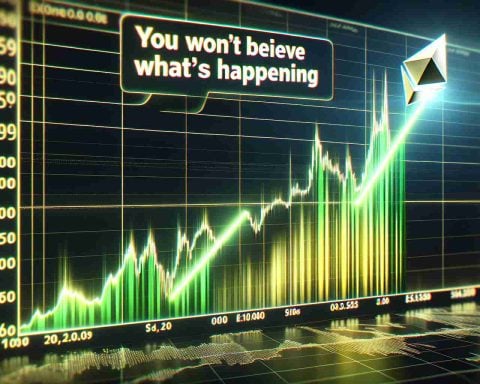Northern Trust, a leader in asset servicing, has introduced a groundbreaking platform that leverages blockchain technology to revolutionize the market for carbon credits. Known as the Northern Trust Carbon Ecosystem, this platform allows institutional investors to seamlessly access and trade carbon credits, linking them directly with project developers committed to combating climate change.
This initiative is powered by Northern Trust’s advanced digital assets platform, Matrix Zenith, and utilizes secure private ledger blockchain technology. By providing a streamlined channel for purchasing and retiring carbon credits, the platform aims to enhance the efficiency and effectiveness of the carbon credit market. With Northern Trust acting as the trusted custodian, institutional buyers can confidently manage their carbon transactions, knowing that each credit purchased is properly documented and settled.
The Carbon Ecosystem has already facilitated its first transactions, with companies such as Water Recovery Systems IP and CUT Carbon Distributed Technologies engaging with institutional buyers to retire credits that represent meaningful strides in reducing greenhouse gas emissions. This initiative not only signifies a growing interest in the Voluntary Carbon Market but also establishes a sustainable framework for managing carbon credits efficiently.
As environmental concerns continue to intensify, Northern Trust’s innovative approach positions it at the forefront of climate solutions, fostering a marketplace that not only advances corporate sustainability goals but also supports global efforts to mitigate climate change.
Northern Trust Unveils Innovative Blockchain Platform for Carbon Credit Transactions
In a significant advancement for environmental finance, Northern Trust has launched its pioneering blockchain-based platform for carbon credit transactions, dubbed the Northern Trust Carbon Ecosystem. This innovative platform aims to streamline the trading of carbon credits, facilitating a more transparent and efficient market that connects institutional investors directly with project developers engaged in climate action.
Understanding the Northern Trust Carbon Ecosystem
The Northern Trust Carbon Ecosystem utilizes a secure private ledger based on advanced blockchain technology, ensuring the integrity and traceability of carbon credit transactions. With this system, institutional investors can opt for a seamless experience in purchasing, tracking, and retiring carbon credits, backed by Northern Trust’s reputation as a reliable custodian in the financial services sector.
Key Questions Addressed
1. What are the main benefits of using blockchain for carbon credit transactions?
– The use of blockchain offers enhanced transparency, as all transactions are securely recorded and immutable. This allows for easier verification of credits and prevents fraud, which has been a significant concern in the carbon credit market. Additionally, automation through smart contracts can reduce transaction costs and time.
2. Who are the primary users of the Carbon Ecosystem?
– The main users will include institutional investors, corporate sustainability departments, and project developers in need of a robust marketplace for buying and selling carbon credits. This platform particularly targets those looking to fulfill emissions reduction commitments under various regulatory frameworks or corporate sustainability goals.
3. How does Northern Trust ensure the quality of carbon credits?
– Northern Trust collaborates with established project developers and environmental organizations to ensure that the carbon credits traded on its platform meet rigorous validation and verification standards. Each project undergoes thorough scrutiny, confirming that it genuinely contributes to emissions reductions.
Challenges and Controversies
Despite the promising framework, several challenges and controversies may hinder the widespread implementation of the Northern Trust Carbon Ecosystem:
– Market Saturation and Oversupply: There is a risk that the market could become flooded with low-quality carbon credits, undermining the integrity of the trading system and diminishing investor confidence.
– Regulatory Uncertainty: Varying regulations across countries can complicate the trade of carbon credits, creating confusion for investors and developers alike. Northern Trust must navigate these complexities to maintain a compliant platform.
– Technological Adoption: Achieving widespread adoption of blockchain among stakeholders in the carbon credit market, many of whom may lack technological expertise or resources, is vital for the platform’s success.
Advantages and Disadvantages
Advantages:
– Increased Transparency: Blockchain provides a clear audit trail for carbon credit transactions.
– Cost Efficiency: The potential for reduced transaction costs through automation can make carbon credits more accessible.
– Enhanced Trust: With Northern Trust acting as a custodian, institutional investors may have increased confidence in the legitimacy of their transactions.
Disadvantages:
– Dependency on Technology: Blockchain technology is still relatively new, and there may be unforeseen technical issues that arise.
– Initial Costs: The development and maintenance of such a platform may require significant investment, which could affect transaction costs in the short term.
– Limited Reach: The platform’s success hinges on the participation of a diverse group of stakeholders, and initial limited adoption could stifle growth.
As Northern Trust’s Carbon Ecosystem continues to gain traction, it may pave the way for new standards in the carbon credit market and support broader climate goals. The ongoing attention towards improving the market’s integrity and efficacy reflects the urgent need for effective solutions in confronting climate change.
For more insights on blockchain applications in finance and sustainable investing, visit Northern Trust.
















